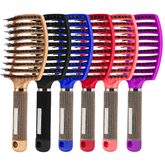When assault causes hair loss: medical steps and support

News reports describe a Newport woman who lost her hair after an attack, a stark reminder that physical violence can have lasting effects on the body — including the hair and scalp. Beyond immediate injuries, assaults can trigger types of hair loss that affect appearance, wellbeing and recovery. This article explains how trauma can lead to hair loss, what medical and psychosocial routes to seek, and practical steps victims and their supporters can take.
How physical and emotional trauma can affect hair
Hair loss after an assault may arise through several mechanisms. Direct physical damage to the scalp — cuts, burns or deep bruising — can destroy hair follicles, potentially causing permanent scarring and irreversible loss in the affected areas. Forceful pulling can produce traction alopecia, where prolonged or intense mechanical tension damages the follicle.
Psychological trauma also plays a role. Significant stress can trigger telogen effluvium, a condition in which many hairs enter the resting (telogen) phase and shed a few months later. Autoimmune responses such as alopecia areata can also be precipitated or exacerbated by stressful events, leading to patchy hair loss. The pattern and prognosis differ by cause, so early assessment is important.
Immediate steps after an assault
If you or someone you support has been assaulted, prioritise safety and medical care. Steps to consider include:
- Seek urgent medical attention for wounds, bleeding or signs of infection — a clinician can also document scalp and hair-related injuries.
- Preserve evidence where possible: photographs of injuries, clothing, and a record of what happened can be vital if you report the incident.
- Consider contacting the police when it is safe to do so. Reporting can open access to additional support services and create an official record of the assault.
- Reach out to support services and charities specialising in domestic abuse for practical and emotional assistance, such as refuge and safety planning.
Medical assessment and treatment options
Book an appointment with your GP as a first port of call; they can examine the scalp, refer you to a dermatologist or a specialised clinic, and arrange investigations if needed. Key points to expect during assessment:
- Clinical examination of the scalp to distinguish scarring from non-scarring hair loss.
- Possible referral for blood tests to check for underlying causes — for example, thyroid or nutritional deficiencies — that might compound hair loss.
- Dermatology input for targeted treatments: non-scarring losses such as telogen effluvium or alopecia areata may recover over months and have medical options to encourage regrowth, while scarring alopecia sometimes requires earlier, specialist intervention to halt progression.
Treatments vary and may include topical therapies, corticosteroid injections for certain inflammatory causes, or surgical approaches for established scarring in selected cases. Your clinician will advise on suitability, risks and timelines. Over-the-counter remedies and unverified treatments should be discussed with a professional before use.
Practical strategies for appearance and wellbeing
While medical care proceeds, managing the visible effects of hair loss can help restore confidence and comfort. Options include:
- Short-term solutions such as wigs, hairpieces, scarves or hats, chosen for comfort and skin sensitivity after scalp injury.
- Scalp care practices that avoid further trauma: gentle cleansing, avoiding harsh chemical treatments and refraining from tight styles that pull on remaining hair.
- Psychological support — counselling or trauma-informed therapy — which can be crucial in processing the experience and its impact on identity.
How friends and family can help
Supportive responses from close contacts make a meaningful difference. Practical ways to help include accompanying someone to appointments, assisting with documentation and reporting when requested, helping research specialist clinics, and respecting the person’s wishes about disclosure. Avoid pressuring someone to discuss details before they are ready, and encourage professional help for both physical and emotional recovery.
Takeaway
Hair loss after assault can be caused by direct scalp injury, mechanical traction or stress-related shedding. Early medical assessment is essential to determine the cause and appropriate care, while emotional and practical support — from healthcare, legal and community services — plays a vital role in recovery. If you or someone you know is affected, seek medical attention, consider specialist dermatology referral, and connect with domestic abuse support services for safety and advocacy.
Explore More: Discover related reads from Hairporium — News • Guides • DIYs • Expert Articles.
More From the Experts: Read interviews and insights from stylists and professionals on Hairporium Expert Articles.







